ZERO DAC
from China
The internet, and ebay.hk especially, is full of these small
silver
boxes. USB dacs, phono stages, standalone dacs, you name it. All of
them are made more or less the same way: they take a good
DAC chip's data sheet, where on last page there is the suggested
circuit, produce a PCB and add a box of choice. Be it Burr Brown,
Analogue Device or Crystal Semiconductors - the same story.

By dual - they mean digitally balanced. Can be converted to XLR easily.
After a friend offered me opportunity to listen to his DAC and modify
it
if possible - I found in the post this ZERO DAC. A one kilo of
electronics. Nice looking and very very small.
This time - the PCB is just a datasheet implementations (of the
CS8416 receiver circuit and Analog
Devices AD1852 DAC chip) - put
together. They also added an opamp based headphone amplifier, its own
volume control and an input selector - toslink - chinch RCA.
I have very good opinion about the AD chips which I tried so far,
especially the AD1862 in my Denon. Also AUDIONOTE and Mr. Kondo seem to
love the AD line. So I was very curious how the new one, stereo
balanced 192kHz / 24 bit compatible cousin will sound like.
Good things first:
1. The PCB is traditional, not SMD,
2. There are many RFI stoppers in the form of ferrite inductors
scattered throughout the pcb. A rare but good practice.
3. Instead of 12 opamps like for example in the Shanling, there is only
ONE OP-AMP in total in the output stage. Half per channel. Very nice
solution !!!
4. There are separate voltage regulators for every "consumer",
totalling 5 regulator chips from the best line of LN 117, better than
usual 7805's.
5. The CS receiver chip is also premium, the best there is. Not
only the DAC
itself
6. Critical caps are premium, like elna silmic in signal decoupling.
7. All electrolytic capacitors have not only a bypass, but TWO
bypass caps 100nF MKT. Very nice especially for a digital product.
8. The transformer is a very powerful 100 VA toroid, unlike the EI
"matchbox" found in other players. It has three secondaries. Very rare
thing.
9. there are 4 diagnostic LEDs on the PCB for easier understanding of
the state.
10. The PCB is large and neat, a pleasure to work on.
11. The opamp is on the socket so it can be upgraded. Even, if the
supplied one is B-Brown OPA2604 - one of the best there is . (if it is
not a fake).
The bad things second:
1. Digital socket is a very flimsy one
2. The output RCA are connected to noise killing caps which shouldn't
be
there at all.
3. The LEDS on the front panel are awfully bright, like in all Chinese
products. Apparently, subtle LED is unknown in Asia.
4. The DAC is not a current output type - Iout. Usually it should mean
a little bit less quality.
That's about all.
Not much of a bad thing, is it ?
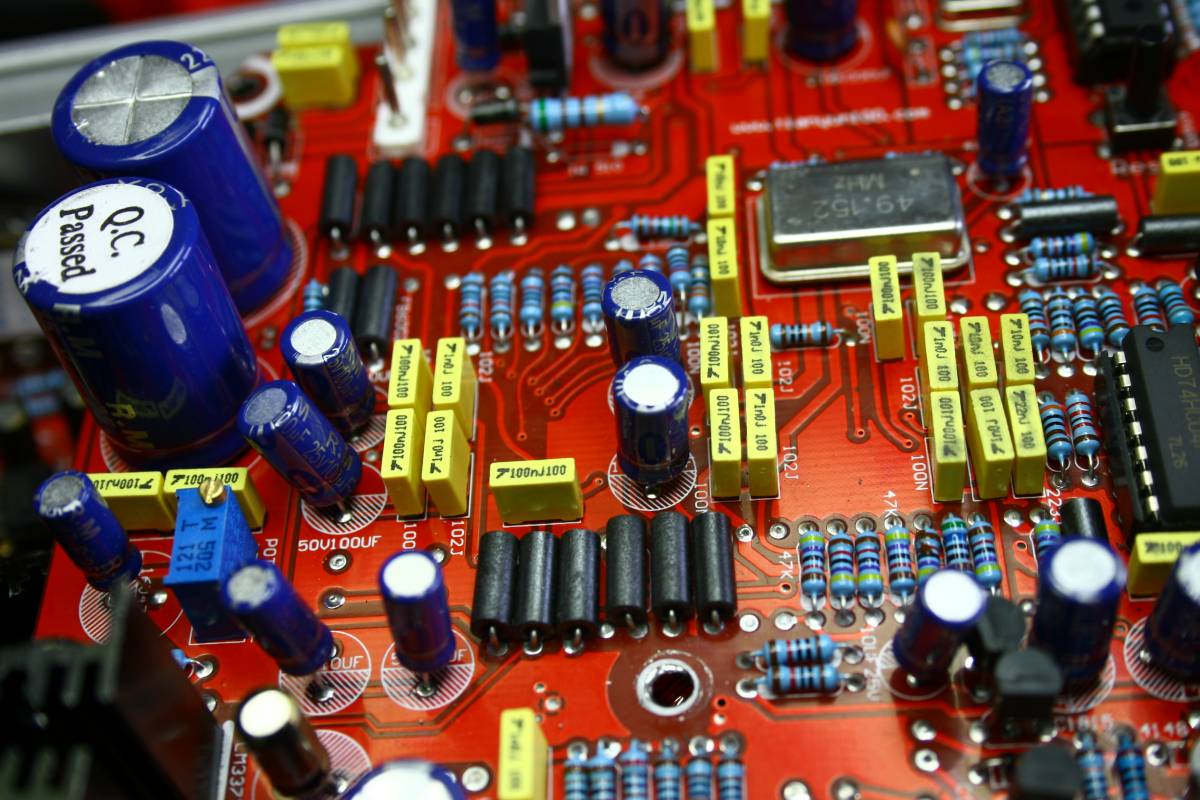
All these yellow caps are bypass for others. Very nice touch.
The black sausages are ferrite noise filters. Also very nice.
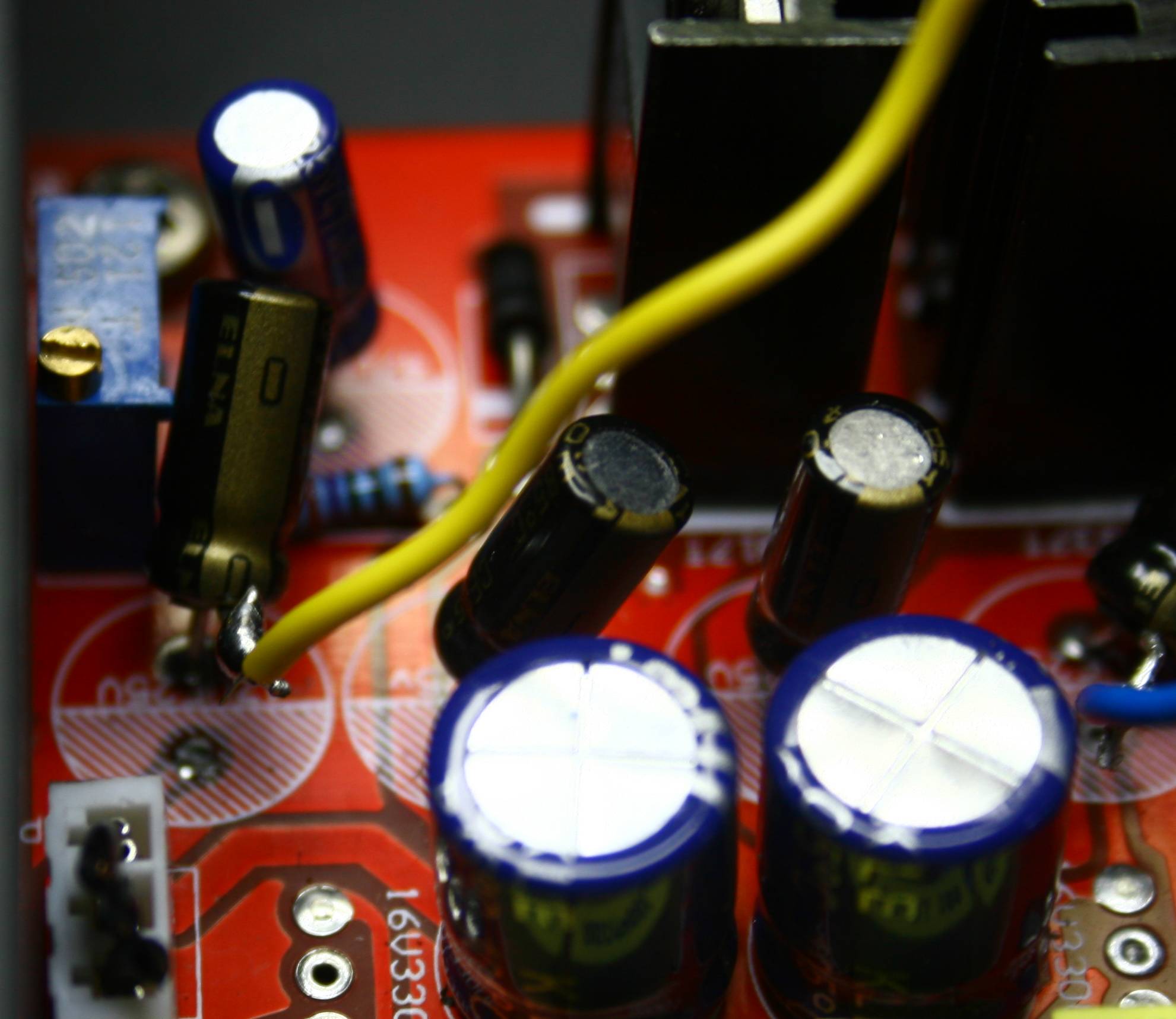
The yellow wire steals the clean signal from the Silmic signal cap with
one leg lifted.
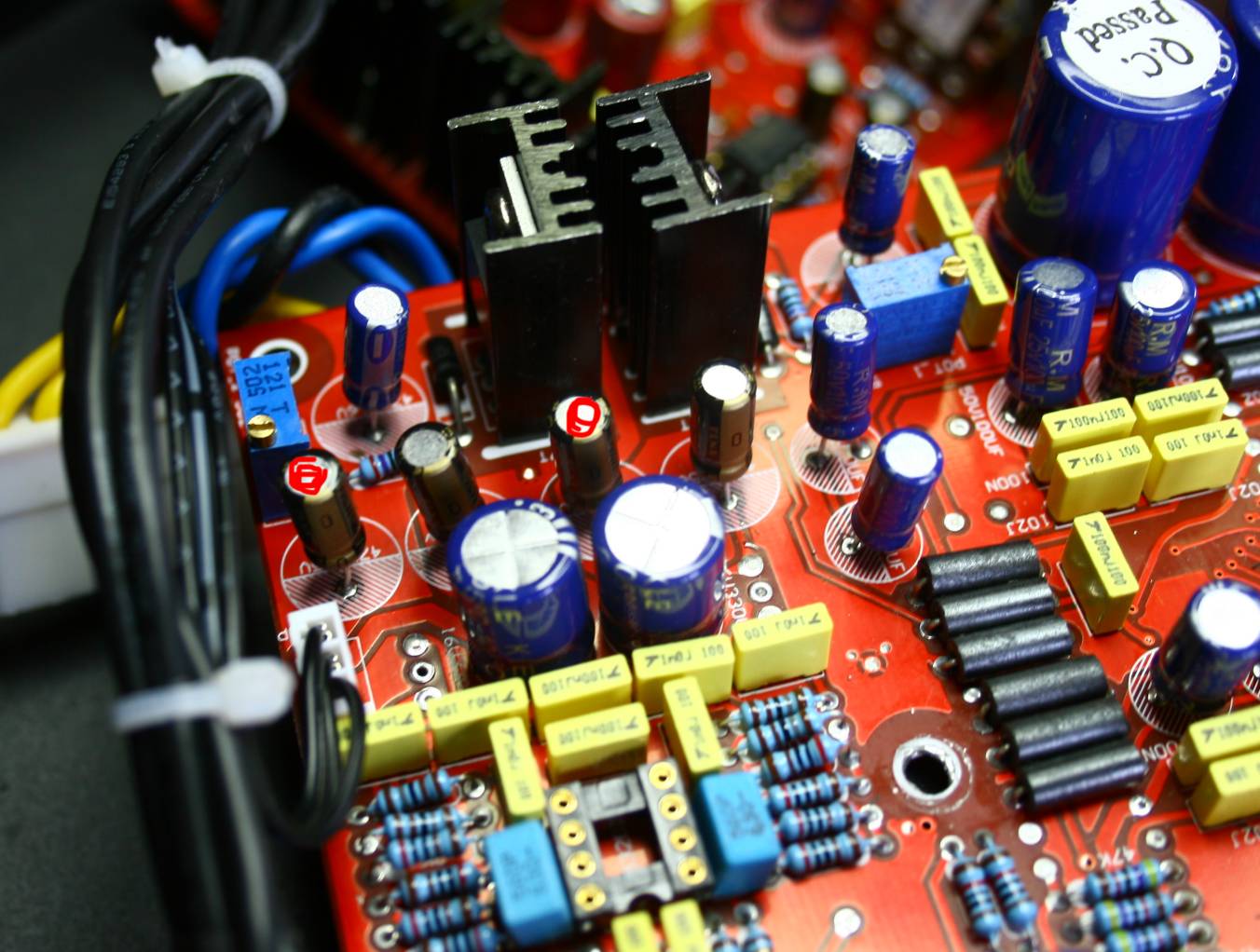
The red marks show which caps are to be lifted for signal stealing.
The opamp is removed from the socket.
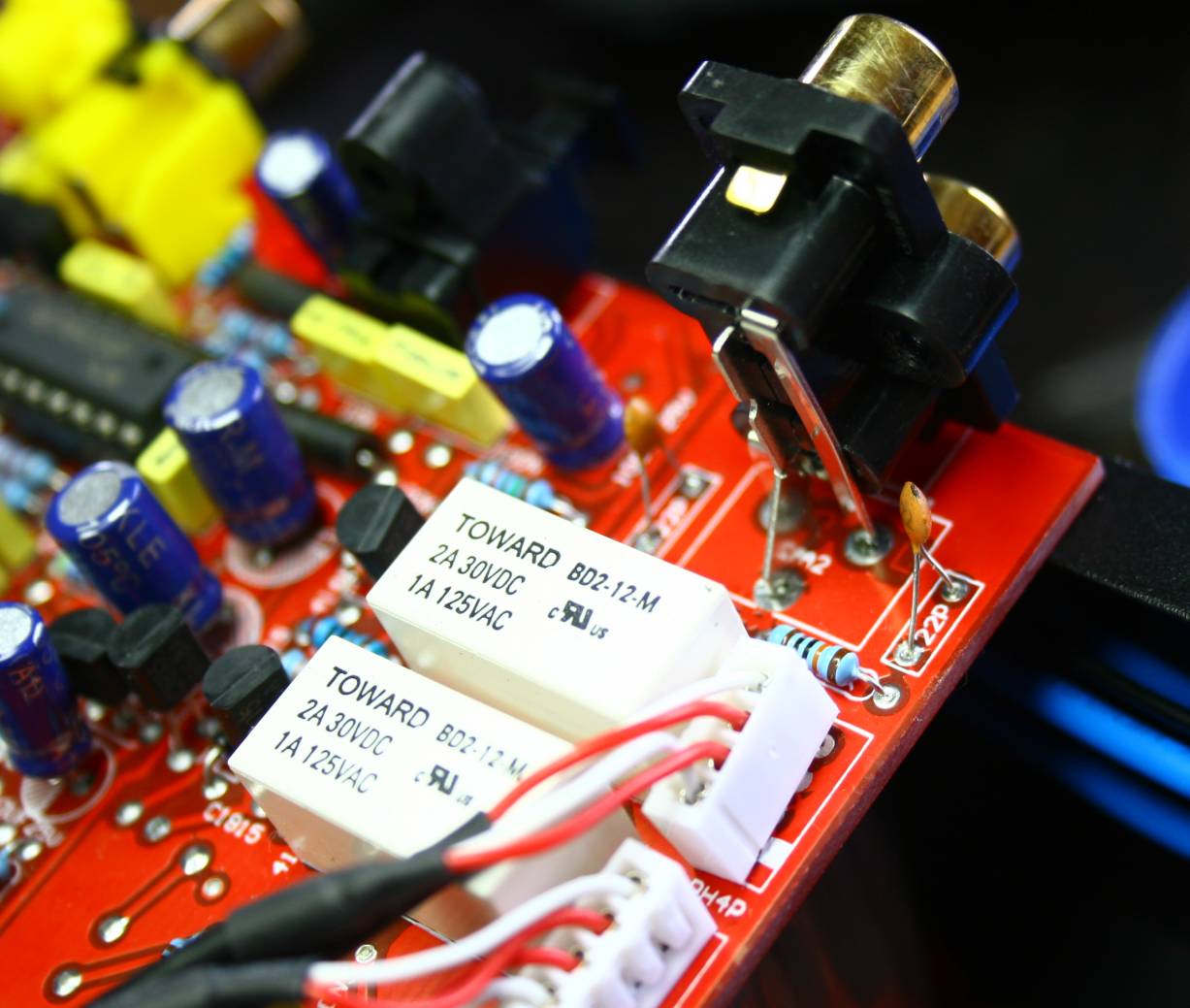
The RCA sockets before removing and their treble killing brown 220p
caps

These tantalum caps are from me, added in parallel to the electrolytes
which power up the DAC and the receiver.
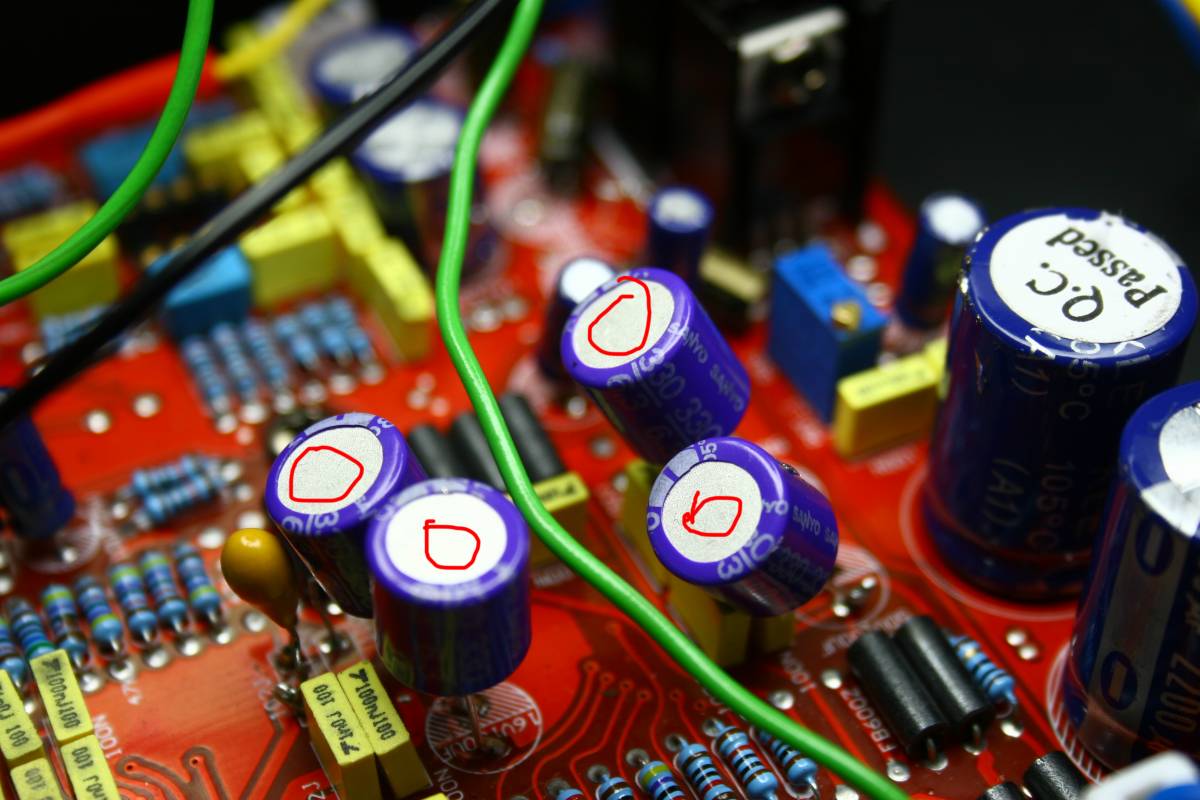
These are four critical caps to be upgraded - power to the DAC and
receiver. I choose os-con.
ZE SOUND
OUT OF THE BOX - the DAC sounds really OK. Nothing exciting but really
OK. Absolutely nothing to complain. I think I can recommend it to
non-tweakers as well. You will not be disappointed.
Bypass job
For the lazy people who don't want to install tubes - the easy SNIPIT
bypass job is to:
1. Remove the existing RCA sockets and install the proper Gucci
jewellery.
2. Lift the MINUS leg of 1st and 3rd decoupling capacitor - see picture
of four Silmic caps in one row. (can be 2nd and 4th as well).
3. Wire the lifted minus leg to the RCA
4. Don't forget to add ground to the RCA's
5. Remove opamp from sockets.
6. If unused - remove the Headphone section altogether.
Enjoy.
Lampization
For the more advanced people - add the lampizator. Since the DAC has
high level output, you need the tube with minimal amplification but big
heart. The 6H6P is the best here.
I proposed for such small box just one tube - two halves as stereo
triodes.
The schematics is the same
as for Anode follower lampucera.
The values are: C1 is the lifted ELNA Silmic cap (10uF electrolyte) and
R-Anode is 10K Ohms, R G in the input grids is 200K - 500K and R
cathode
is 200 Ohms.
Power supply electrolytes should be over 220 uF and the I anode is
circa 8-10- mA. Voltage on the signal output (on anode) is 85 V DC.
The decoupling signal caps from anodes to RCA's should be over 1
uF and over 160 VDC rating !
The best of course are copper foil paper in oil from Jensen or
Audionote.
For filament of one triode we do not need a DC rectified filtered
power. We can use AC straight from 6,3 V DC secondary of the
transformer. (see my yellow twisted pair below)

The first test run of the lampizator.

The Lampizator ZERO DAC in full glory, presenting proudly the big macho
tube 6H6P.
Ze post-lampization sound
Which is the most common language in the world ???
Chinese ?
Not ...
Think again ...
Spanish ?
nope ...
Yes !
it is bad English.
The same principle applies to CD playback. The most common system is
good DAC chip and lousy analogue output stage.
In Zero dac it is no different. Excellent chip is followed by bad
output
stage. Not nearly as bad as the really bad ones, but nevertheless
killing all the subtle nuances.
With lampizator which takes the signal directly from DAC legs -
the sound opens up incredibly. I rank it really very high. It is warm,
full, extended, wide, deep, natural, powerful and musical. I would say
it is equally good as CS4397 which is a hell of recommendation !
It is less detailed than CS but more warm and musical. The differences
are super small. Anyway, I suggest that this is an extremely safe buy,
worth the effort of lampization and it beats 90 % of other lampized
players. It is about equal to B-B PCM1794 . Personally I liked it very
much. Particularly the bass is surprisingly good. All in all - for a
mere U Out DAC this is spectacular.
It gets my seal of approval and it belongs in upper part of class one of
players. Almost class zero really.








